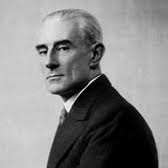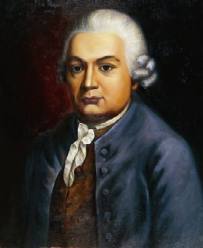March 5, 2012. Ravel and C. P. E. Bach.Maurice Ravel was born on the 7th of March, 1875 in Ciboure, a French Basque town on the border with Spain. This most French composer had a Swiss-born father (Igor Stravinsky, a good friend, called Ravel “the most perfect of Swiss watchmakers”) and a Basque mother who, prior to marrying Joseph Ravel, spent most of her life to Madrid. Around 1900 Ravel joined a group of French musicians, writers and artists, who called themselves Les Apaches (in French the word not only refers to the native American tribe but also means hooligans). Besides Ravel (and later Stravinsky), composers Florent Schmitt and Manuel de Falla also belonged to the band. Ricardo Viñes, the pianist who premiered many of Ravel’s compositions, was a member. Ravel even suggested a musical theme for the group, a rather wild and exotic entry to Borodin’s Second symphony. Ravel dedicated his piano suite Miroirs, written in 1905, to Les Apaches, and each of the five movements to a different person: Noctuelles to the poet Léon-Paul Fargue; Oiseaux tristes – to Ricardo Viñes, who premiered this work in 1906, Une barque sur l'océan – to the painter Paul Sordes (for many years the group met every Saturday at his home); Alborada del gracioso was dedicated to the music critic Michel-Dimitri Calvocoressi, a big fan of Russian music, especially that of Mussorgsky and an advisor to Sergei Dyaghilev; and La vallée des cloches – to the composer and pianist Maurice Delage. We’ll hear all five: Noctuelles is performed by the Italian pianist Igor Cognolato (here); Oiseaux tristes by the Chinese-born pianist Di Wu (here); Une barque sur l'océan – by Spencer Myer (here) Alborada del gracioso – by Milton Rubén Laufer (here), and La vallée des cloches – again by Igor Congnolato (here).
If we were asked to name a composer farthest removed musically from Ravel, Carl Philipp Emanuel Bach probably would make the list. But here he is, born the same week, on March 8, 1714. The fifth child of Johan Sebastian Bach became an important composer in his own right, one of the most significant composers of the era straddling Baroque and Classicism. His father was a great influence on him, as was his godfather, Georg Philipp Telemann, who in his time was at least as popular as J. S. Bach, if not more so. Emanuel Bach was born in Weimar, studied at the famous St. Thomas School at Leipzig (his father became a cantor there just a year before he entered the school, in 1723), and then for 30 years lived in Berlin. He started his service at the court of Crown Prince Frederick of Prussia in 1738. Two years later Frederick (who became known as Frederick the Great) succeeded his father as the king of Prussia, and Emanuel joined the royal orchestra. By then he was already famous as a harpsichordist and composer. The Berlin period was very prolific for Emanuel: he wrote a large number of keyboard sonatas and several orchestral pieces, among them a Magnificat and several symphonies. In 1768 Emanuel left the service of Frederick to become the court composer for his sister, Princess Anna Amalia in Hamburg – a post previously occupied by his godfather, Georg Philipp Telemann. That was the time when Emanuel wrote most of his choral pieces, including the oratorio Die Israeliten in der Wüste (The Israelites in the Desert), cantatas, and different settings of the Passion. He died on December 14, 1788. Mozart, who regarded him very highly and called himself and other contemporary composers of the time "children of Emanuel Bach," was by then at the pinnacle of his career. We’ll hear Rondo in F Major, Wq. 57 performed by the young Israeli pianist Einav Yarden (here) and Flute Sonata in G Major (here), performed by the flutists Martha Councell with Richard Steinbach on the piano.
Ravel and C. P. E. Bach 2012
March 5, 2012. Ravel and C. P. E. Bach. Maurice Ravel was born on the 7th of March, 1875 in Ciboure, a French Basque town on the border with Spain. This most French composer had a Swiss-born father (Igor Stravinsky, a good friend, called Ravel “the most perfect of Swiss watchmakers”) and a Basque mother who, prior to marrying Joseph Ravel, spent most of her life to Madrid. Around 1900 Ravel joined a group of French musicians, writers and artists, who called themselves Les Apaches (in French the word not only refers to the native American tribe but also means hooligans). Besides Ravel (and later Stravinsky), composers Florent Schmitt and Manuel de Falla also belonged to the band. Ricardo Viñes, the pianist who premiered many of Ravel’s compositions, was a member. Ravel even suggested a musical theme for the group, a rather wild and exotic entry to Borodin’s Second symphony. Ravel dedicated his piano suite Miroirs, written in 1905, to Les Apaches, and each of the five movements to a different person: Noctuelles to the poet Léon-Paul Fargue; Oiseaux tristes – to Ricardo Viñes, who premiered this work in 1906, Une barque sur l'océan – to the painter Paul Sordes (for many years the group met every Saturday at his home); Alborada del gracioso was dedicated to the music critic Michel-Dimitri Calvocoressi, a big fan of Russian music, especially that of Mussorgsky and an advisor to Sergei Dyaghilev; and La vallée des cloches – to the composer and pianist Maurice Delage. We’ll hear all five: Noctuelles is performed by the Italian pianist Igor Cognolato (here); Oiseaux tristes by the Chinese-born pianist Di Wu (here); Une barque sur l'océan – by Spencer Myer (here) Alborada del gracioso – by Milton Rubén Laufer (here), and La vallée des cloches – again by Igor Congnolato (here).
Swiss-born father (Igor Stravinsky, a good friend, called Ravel “the most perfect of Swiss watchmakers”) and a Basque mother who, prior to marrying Joseph Ravel, spent most of her life to Madrid. Around 1900 Ravel joined a group of French musicians, writers and artists, who called themselves Les Apaches (in French the word not only refers to the native American tribe but also means hooligans). Besides Ravel (and later Stravinsky), composers Florent Schmitt and Manuel de Falla also belonged to the band. Ricardo Viñes, the pianist who premiered many of Ravel’s compositions, was a member. Ravel even suggested a musical theme for the group, a rather wild and exotic entry to Borodin’s Second symphony. Ravel dedicated his piano suite Miroirs, written in 1905, to Les Apaches, and each of the five movements to a different person: Noctuelles to the poet Léon-Paul Fargue; Oiseaux tristes – to Ricardo Viñes, who premiered this work in 1906, Une barque sur l'océan – to the painter Paul Sordes (for many years the group met every Saturday at his home); Alborada del gracioso was dedicated to the music critic Michel-Dimitri Calvocoressi, a big fan of Russian music, especially that of Mussorgsky and an advisor to Sergei Dyaghilev; and La vallée des cloches – to the composer and pianist Maurice Delage. We’ll hear all five: Noctuelles is performed by the Italian pianist Igor Cognolato (here); Oiseaux tristes by the Chinese-born pianist Di Wu (here); Une barque sur l'océan – by Spencer Myer (here) Alborada del gracioso – by Milton Rubén Laufer (here), and La vallée des cloches – again by Igor Congnolato (here).
If we were asked to name a composer farthest removed musically from Ravel, Carl Philipp Emanuel Bach probably would make the list. But here he is, born the same week, on March 8, 1714. The fifth child of Johan Sebastian Bach became an important composer in his own right, one of the most significant composers of the era straddling Baroque and Classicism. His father was a great influence on him, as was his godfather, Georg Philipp Telemann, who in his time was at least as popular as J. S. Bach, if not more so. Emanuel Bach was born in Weimar, studied at the famous St. Thomas School at Leipzig (his father became a cantor there just a year before he entered the school, in 1723), and then for 30 years lived in Berlin. He started his service at the court of Crown Prince Frederick of Prussia in 1738. Two years later Frederick (who became known as Frederick the Great) succeeded his father as the king of Prussia, and Emanuel joined the royal orchestra. By then he was already famous as a harpsichordist and composer. The Berlin period was very prolific for Emanuel: he wrote a large number of keyboard sonatas and several orchestral pieces, among them a Magnificat and several symphonies. In 1768 Emanuel left the service of Frederick to become the court composer for his sister, Princess Anna Amalia in Hamburg – a post previously occupied by his godfather, Georg Philipp Telemann. That was the time when Emanuel wrote most of his choral pieces, including the oratorio Die Israeliten in der Wüste (The Israelites in the Desert), cantatas, and different settings of the Passion. He died on December 14, 1788. Mozart, who regarded him very highly and called himself and other contemporary composers of the time "children of Emanuel Bach," was by then at the pinnacle of his career. We’ll hear Rondo in F Major, Wq. 57 performed by the young Israeli pianist Einav Yarden (here) and Flute Sonata in G Major (here), performed by the flutists Martha Councell with Richard Steinbach on the piano.
March 8, 1714. The fifth child of Johan Sebastian Bach became an important composer in his own right, one of the most significant composers of the era straddling Baroque and Classicism. His father was a great influence on him, as was his godfather, Georg Philipp Telemann, who in his time was at least as popular as J. S. Bach, if not more so. Emanuel Bach was born in Weimar, studied at the famous St. Thomas School at Leipzig (his father became a cantor there just a year before he entered the school, in 1723), and then for 30 years lived in Berlin. He started his service at the court of Crown Prince Frederick of Prussia in 1738. Two years later Frederick (who became known as Frederick the Great) succeeded his father as the king of Prussia, and Emanuel joined the royal orchestra. By then he was already famous as a harpsichordist and composer. The Berlin period was very prolific for Emanuel: he wrote a large number of keyboard sonatas and several orchestral pieces, among them a Magnificat and several symphonies. In 1768 Emanuel left the service of Frederick to become the court composer for his sister, Princess Anna Amalia in Hamburg – a post previously occupied by his godfather, Georg Philipp Telemann. That was the time when Emanuel wrote most of his choral pieces, including the oratorio Die Israeliten in der Wüste (The Israelites in the Desert), cantatas, and different settings of the Passion. He died on December 14, 1788. Mozart, who regarded him very highly and called himself and other contemporary composers of the time "children of Emanuel Bach," was by then at the pinnacle of his career. We’ll hear Rondo in F Major, Wq. 57 performed by the young Israeli pianist Einav Yarden (here) and Flute Sonata in G Major (here), performed by the flutists Martha Councell with Richard Steinbach on the piano.